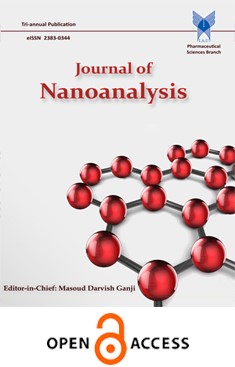Adsorption Behaviors of Curcumin on N-doped TiO2 Anatase Nanoparticles: Density Functional Theory Calculations
محورهای موضوعی : Journal of NanoanalysisAmirali Abbasi 1 , Jaber Jahanbin Sardroodi 2
1 - Molecular Simulation Laboratory (MSL), Azarbaijan Shahid Madani University, Tabriz, Iran|Computational Nanomaterials Research Group (CNRG), Azarbaijan Shahid Madani University, Tabriz, Iran|Department of Chemistry, Faculty of Basic Sciences, Azarbaijan Shahid Madani University, Tabriz, Iran
2 - Molecular Simulation Laboratory (MSL), Azarbaijan Shahid Madani University, Tabriz, Iran|Computational Nanomaterials Research Group (CNRG), Azarbaijan Shahid Madani University, Tabriz, Iran|Department of Chemistry, Faculty of Basic Sciences, Azarbaijan Shahid Madani University, Tabriz, Iran
کلید واژه: Curcumin, density functional theory, Tio2 Nanoparticle, Adsorption, Molecular orbital,
چکیده مقاله :
The density functional theory (DFT) calculations were used to get information concerning the interaction of curcumin with pristine and N-doped TiO2 anatase nanoparticles. Three adsorption geometries of curcumin over the TiO2 anatase nanoparticles were studied in order to fully exploit the sensing properties of TiO2 nanoparticles. Curcumin molecule adsorbs on the fivefold coordinated titanium sites of the TiO2 nanoparticle because of the higher affinity of these sites with respect to the curcumin molecule. A preferred perpendicular adsorption of curcumin on the OC-substituted nanoparticle was found to be the most favorable conformation with the estimated adsorption energy of about -5.33 eV. The results suggest that the curcumin molecule favorably interacts with the N-doped TiO2 nanoparticle, that is, the interaction of curcumin with the pristine nanoparticle is less favorable in energy than the interaction with the N-doped one. The structural parameters such as bond lengths/angles and adsorption energies were examined for the discussion of results. The electronic structures of the system were analyzed in view of the density of states and molecular orbitals. The analysis of projected density of states and molecular orbitals showed forming new chemical bonds between the nanoparticle and curcumin molecule. By including vdW interactions, the adsorption energies of the most stable curcumin+TiO2 couples were increased, implying the dominant effect of dispersion energy.
1. M.R. Hoffmann, S.T. Matin, W. Choi and D.W. Bahnemann, J. Chem. Rev., 95, 69 (1995).
2. K. Shankar, J.I. Basham, N.K. Allam, O.K. Varghese, G.K. Mor and X. Feng, Phys. Chem. C., 113, 6327 (2009).
3. U. Diebold, Surf. Sci. Reports, 48, 53 (2003).
4. A. Fujishima, X. Zhang and D.A. Tryk, Surf. Sci. Reports, 63, 515 (2008).
5. F. Han, V.S.R. Kambala, M. Srinivasan, D. Rajarathnam and R. Naidu, Applied Catalysis A: General, 359, 25 (2009).
6. A. Abbasi and J.J. Sardroodi, Int. J. Bio-Inorg. Hybr. Nanomater., 5, 43 (2016).
7. M.M. Rodriguez, X. Peng, L. Liu, Y. Li and J.M. Andino, Phys. Chem. C., 116(37), 19755 (2012).
8. M.L. Caariainen, T.O. Kaariainen and D.C. Cameron, Thin Solid Films, 517, 6666 (2009).
9. R. Erdogan, O. Ozbek and I. Onal, Surf. Sci., 604, 1029 (2010).
10. H. Liu, M. Zhao, Y. Lei, C. Pan and W. Xiao, Comput. Mat. Sci., 15, 389 (2012).
11. R. Hummatov, O. Gulseren, E. Ozensoy, D. Toffol and H. Ustunel, Phys. Chem. 116, 6191 (2012).
12. J. Liu, Q. Liu, P. Fang, C. Pan and W. Xiao, Appl. Surf. Sci., 258, 8312 (2012).
13. W.J. Yin, S. Chen, J.H. Yang, X.G. Gong, Y. Yan and S.H. Wei, Appl. Phys. Letts., 96, 221901 (2010).
14. S. Livraghi, M.C. Paganini, E. Giamello, A. Selloni, C.D. Valentin and G. Pacchioni, J. Am. Chem. Soc., 128, 15666 (2006).
15. H. Gao, J. Zhou, D. Dai and Y. Qu, J. Chem. Eng. Technol., 32, 867 (2009).
16. H. Irie, Y. Watanabe, and K. Hashimoto, Phys. Chem. B., 107(23), 5483 (2003).
17. Q. Chen, C. Tang and G. Zheng, Physica B: Condens. Matter, 404, 1074 (2009).
18. A. Abbasi and J. J. Sardroodi, Int. J. Nano Dimens., 7, 349, (2016).
19. I.A. Guzei, A.G. Baboul, G.P.A. Yap, A.L. Rheingold, H.B. Schlegel and C.H. Winter. J. Am. Chem. Soc., 119, 3387 (1997).
20. J. Liu, L. Dong, W. Guo, T. Liang and W. Lai, Phys. Chem. C., 117, 13037 (2013).
21. A. Abbasi and J. J. Sardroodi, J. Water Environ. Nanotechnol., 2, 52 (2017).
22. R. Liu, X. Zhou, F. Yang and Y. Yu, Appl. Surf. Sci., 319, 50 (2014).
23. Z. Zhao and Q. Liu, J. Phys. D: Appl. Phys., 41, 085417 (2008).
24. S. Tang and Z. Cao, J. Chem. Phys., 134, 044710 (2011).
25. S. Tang and J. Zhu, RSC Adv., 4, 23084 (2014).
26. A. Abbasi and J.J. Sardroodi, Int. J. Bio-Inorg. Hybr. Nanomater., 5, 105 (2016).
27. A. Abbasi, J.J. Sardroodi and A. R. Ebrahimzadeh, J. Water Environ. Nanotechnol., 1, 55 (2016).
28. Z.M. Abou-Gamra and M.A. Ahmed, Journal of Photochemistry and Photobiology B: Biology, 160, 134 (2016).
29. V.J. Sawant and R.V. Kupwade, Der Pharmacia Lettre, 7, 37 (2015).
30. U. Singh, S. Verma, H.N. Ghosh, M.C. Rath, K.I. Priyadarsini, A. Sharma, K.K. Pushpa, S.K. Sarkar and T. Mukherjee, Journal of Molecular Catalysis A: Chemical, 318, 106 (2010).
31. S. Buddee, S. Wongnawa, P. Sriprang and C. Sriwong, Journal of Nanoparticle Research, 16, 2336 (2014).
32. P. Hohenberg and W. Kohn, Phys. Rev., 136, B864 (1964).
33. W. Kohn and L. Sham, Phys. Rev., 140, A1133 (1965).
34. The code, OPENMX, pseudoatomic basis functions, and pseudopotentials are available on a web site 'http://www.openmxsquare.org'.
35. T. Ozaki and H. Kino, Numerical atomic basis orbitals from H to Kr, Phys. Rev. B., 195113 69 (2004).
36. J.P. Perdew and A. Zunger, Phys. Rev. B., 23, 5048 (1981).
37. A. Koklj, Comput. Mater. Sci., 28, 155 (2003).
38. S. Grimme, J. Comput. Chem., 27(15), 1787 (2006).
39. The data available at 'http://rruff.geo.arizona.edu/AMS/amcsd.php'.
40. R.W.G. Wyckoff. Crystal structures, Second edition. Interscience Publishers, USA, New York, (1963).
41. Y. Lei, H. Liu and W. Xiao, J. Modelling Simul. Mater. Sci. Eng., 18, 025004 (2010).
42. A. Abbasi, J. J. Sardroodi and A. R. Ebrahimzadeh, Surf. Sci., 654, 20 (2016).


